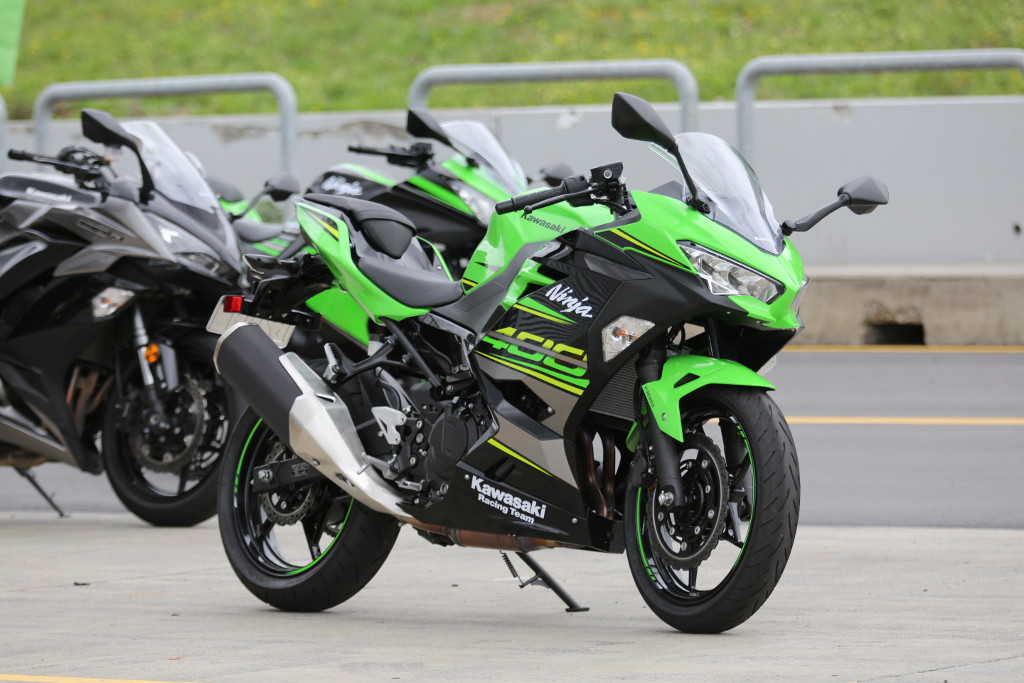Kawasaki has launched the hotly anticipated Z900RS along with the new and highly improved addition to the Ninja family, the Ninja 400. Were they worth the wait since they were launched internationally a couple of months ago? Damn right!
Words: Mat Pics: Kerry and Kawasaki
Pukekohe Park Raceway seems an odd place to launch a bike like the Z900RS. The track is after all, more home to the Ninja 400 (more on that later) but the big new Zed is in Kawasaki’s own words: ‘not a thrash bike’, so why were we here?

Well, it turns out there’s no way we’d get to really see just how good Kawasaki’s new Modern Classic class contender is with the legal speed limit slowing us down, and despite the bike’s lower state of tune compared to last year’s Z900, it can still hustle.
Readers of a certain age will immediately recognise where Kawasaki drew inspiration from for the Z900RS.
The rear of the bike is purposely designed to evoke the duck-tail of the original Z1 and that’s not the only piece of styling the modern bike has pinched out of Grandad’s parts bin.

The analogue instrumentation combines with a centrally mounted LCD screen, which displays all the info we’ve become accustomed to seeing in the 21st Century, all while retaining the cool, bullet design to their shape. Looking at the beautiful Z1 on display at the launch, I was stunned just by how similar the clocks look from side on. Kawasaki did a masterful job here.
“This is a classic bike that says; ‘take me out on a joyride’,” says Kawasaki NZ General Manager Mike Cotter. “It’s not a bike to thrash.”
“True Spirit” is the tagline for the Z900RS, and Kawasaki Heavy Industries went to “great pains” to ensure the bike met the brief.

In pre-production, Kawasaki reportedly redesigned the bike’s frame twice to ensure everything was ‘just right’, including how the 17-litre fuel tank visually appeared. The size of the fuel tank itself is understandably a concession to the requirements of the modern rider, who wants the power of a near-on litre machine, but doesn’t want to fill up every 100 kilometres. Kawasaki’s fiddling to get the frame and tank combo right clearly paid off, as it is not until you walk up to the Z900RS that the size really hits you.
This attention to detail goes even so far as the construction of the exhaust headers, with Kawasaki opting to use double-walled pipes to both discourage discolouration, and also give the bike more visual presence.
Behind the engine casing is a heavier flywheel to that of the Z900, which – along with other tuning tweaks to the 948cc engine – helps to move the powerband lower in the rev range to give the rider more usable power on the street.
Out on the track you definitely notice the bike runs out of mojo in the higher reaches of its rev range, but out of the corners in the middle of its torque wave, it really can punch its way out with vigour.

If it weren’t for the footpegs hindering ground clearance, you could really keep the Z900RS in the sweet spot the whole way around Puke’.
Sure, it is no racer, but in a segment often all about meeting the classic look without following through to offering a truly modern ride, the Z900RS is a real revelation within its class.
It is definitely worthy of the True Spirit moniker as well as its premium pricing on the “modern” Z900, which sits at $19,995 plus on roads.
NEXT LEVEL NINJA

When it came to the baby bike of the launch – the Ninja 400 – it was all smiles from us.
Kawasaki has redesigned the LAMS-class racer to further enhance the riding experience as well as get a nose out ahead of the competition in terms of capacity and build quality.

10 years on from the original Ninja 250 launch, the bike has nearly doubled in capacity, growing to 399cc.
It is interesting to note that Kawasaki New Zealand opted for the same LAMS version as Australia gets, which is detuned slightly to keep it under the 150kw per tonne limit.
Despite this, the bike still puts out a very usable 45hp at 10,000rpm, backed by 38Nm of torque. That’s 6hp and 11Nm more than the 300 put out.
Despite the bigger engine and a new frame inspired by the H2, the new Ninja retains the same seat height as the outgoing 300cc model – but that is about all they have in common.

Hitting the track on the Ninja 400 after a quick jaunt on the 2017 300, it was immediately clear that the new bike is head and shoulders above the old.
Everything from tyre choice, to braking feel, to the all-important power has improved. Let’s not even go near how much better the new bike looks.
One thing of note that did get a little annoying on the track however, was the petal disc brakes making a heck of a noise on hard deceleration – to the point we thought the horn was activating.

It was annoying, but the added braking ability of the new bike’s larger 310mm front disc is worth it, especially in terms of feel at the lever.
With a wide range of bikes on offer to play with – along with the new bikes – the fact that we all gravitated back to the Ninja 400 said a lot about just how much fun the bike is.
When you’ve got the option for 650s, 900s and even 1000s, the gravitational pull of the fun factory that is the $7,995 Ninja 400 will likely translate to more riders picking to side with Team Green in the coming year.

















